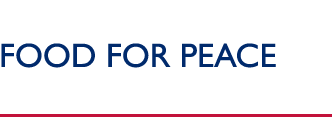 |
|
 |
 |
 |
 Introduction Introduction
Home
- List of Acronyms
- List of Cooperating Sponsors
- Conversion Tables
Part One
Section I:
Commodities
- Commodity Availability
- Commodity Characteristics
- References
Section II:
Food Commodity
Fact Sheets
- Beans, Black
- Beans, Great Northern
- Beans, Kidney (Light Red, Dark Red, All types)
- Beans, Navy (Pea Beans)
- Beans, Pink
- Beans, Pinto
- Beans, Small Red
- Bulgur (BW)
- Bulgur, Soy Fortified (SFBW)
- Corn (bagged, bulk)
- Cornmeal
- Cornmeal, Soy-Fortified (CMSF)
- Corn Soy Blend (CSB)
- Corn Soy Milk (CSM)
- Corn Soy Milk, Instant (ICSM)
- Lentils
- Non Fat Dry Milk (NFDM)
- Peas
- Rice
- Rice (Parboiled)
- Sorghum
- Sorghum Grits, Soy-Fortified (SFSG)
- Fortified Refined Vegetable Oil
- Wheat
- Wheat Flour
- Wheat Soy Blend (WSB)
- Wheat Soy Milk (WSM)
Section III:
Storage/Shelflife
Specifications
- Storage Specifications
- Storage Inspection Checklist
- Shelf Life of Agricultural Commodities
- References
Section IV:
Controlling
Damage to Food
Commodities
- Cleaning and Inspecting
- Insect Control
- Rodent Control
- Reference Chart for Controlling Damage to Food Commodities
- References
 Part Two Part Two
 An Overview An Overview
 Part Three Part Three
|
|
 |
 |
|
Section II: Food Commodity Fact Sheets |
 |
Updated January 2006
Wheat Soy Blend
This
processed, blended
commodity is used primarily as a weaning food, mixed with water as a
beverage or gruel, in Maternal Child Health (MCH) and emergency
programs. It is used to a lesser extent in other types of programs.
1.
Nutritive Values (per 100 g)
These are average values, taken from the U.S. Department of
Agriculture, Agricultural Research Service (USDA:ARS) 1998 USDA
Nutrient Database, Release 12, Laboratory Home Page (http://www.nal.usda.gov/fnic/foodcomp).
These nutrient values are provided as a guide for use in the
calculation of food aid rations; users should realize food aid may vary
from these exact nutrient values. The values for thiamin, riboflavin,
niacin, vitamin A, calcium and iron represent the total of the natural
values plus the minimum specification (converted to a 100 g basis). NOTE:
The values do not contain nutrients from Wheat Protein Concentrate;
values for water, energy, protein, lipids, carbohydrates, and fiber
were estimated.
| Nutrient |
Amount |
Unit |
| Water |
8.8 |
g |
| Energy |
354.5 |
Kcal |
| Protein |
21.5 |
g |
| Total Lipid |
5.9 |
g |
| Carbohydrate |
46.9 |
g |
| Fiber,
total dietary |
13.18 |
g |
| Ash |
2.0 |
g |
| Calcium |
842 |
mg |
| Iron |
17.85 |
mg |
| Magnesium |
227.26 |
mg |
| Phosphorus |
294 |
mg |
| Potassium |
694 |
mg |
| Sodium |
13.8 |
mg |
| Zinc |
5.5 |
mg |
| Copper |
1.0 |
mg |
| Manganese |
2.2 |
mg |
| Selenium |
2.0 |
mcg |
| Vitamin C |
40 |
mg |
| Thiamin |
0.54 |
mg |
| Riboflavin |
0.50 |
mg |
| Niacin |
8.19 |
mg |
| Pantothenic acid |
3.7 |
mg |
| Vitamin B-6 |
0.47 1 |
mg |
| Folate |
275 |
mcg |
| Vitamin
B-12 |
1 |
mcg |
| Vitamin A |
2323.00 |
IU |
| Vitamin E |
8.3 |
mg-ATE |
| Vitamin D |
198 |
IU |
| Iodine |
56.88 |
mcg |
1 0.17 mg added as Pyridoxine HCL.
2.
Components:
53% Bulgur Flour
20% Wheat Protein Concentrate (WPC)
20% Soy Flour, defatted.
4% Soybean Oil, stabilized.
3% Vitamins & Minerals, added as premix.
3.
Specifications:
Milled and processed from bulgur flour, defatted soy-flour, and soybean
oil.
The wheat-soy blend shall conform in every respect to the provisions of
the "Federal Food, Drug, and Cosmetic Act," as amended, and the
regulations promulgated thereunder, including any Defect Action Level
guidelines issued by the Food and Drug Administration (FDA) which may
be applicable to wheat-soy blend.
Salmonella,
E. Coli and Coagulase Positive Staphylococci will be negative.
CHEMICAL
AND PHYSICAL REQUIREMENTS
| ITEM 1 |
Minimum |
Maximum |
| Moisture, % |
-- |
11.0 |
| Protein (Nx6.25), %
|
20.0 |
-- |
| Crude Fat, % |
6.0 |
-- |
| Ash, % |
-- |
6.6 |
| Crude Fiber, % |
-- |
2.5 |
| Lysine, % |
0.9 |
-- |
| Total Bacteria Count
per gram |
-- |
50,000 |
1 Unless otherwise specified, all
analyses except moisture are expressed on a moisture-free basis.
(Source: USDA:FSA:PDD:EOB November,
1997 (Contact Tel: 202-690-3565)
4.
Packaging:
25 kg (55 lb.) multi-wall
paper bags. Three plies of paper (minimum) with an inner polyethylene
plastic liner. The outer paper ply is treated to provide wet strength
and must have a plastic liner facing the product of 3 mil (minimum) low
density polyethylene.
5.
Shelf Life:
At least one year. See "Section III: Storage/Shelf
Life Specifications" for more information.
Fact Sheet Download:
|


